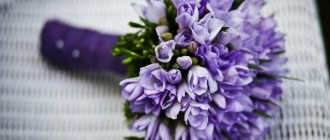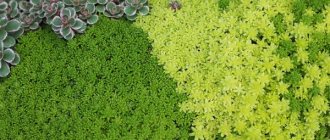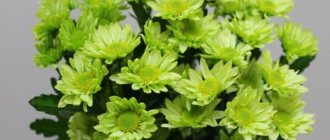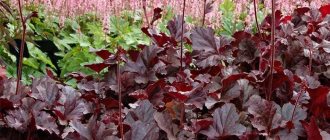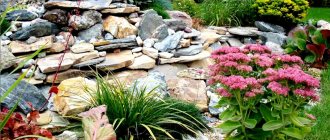If you were looking for a detailed description of the different types and most popular varieties of hostas, you are on the right track. This article contains a guide to the world of hosts with photos and detailed descriptions.
Hosta is an indispensable plant for the garden. She is unpretentious, shade-tolerant, and beautiful. Although at first glance the different types and varieties of hosta may seem almost identical, in fact there are a huge variety of them. Our article will help you navigate this diversity.
A frequent “companion” of hosta is garden heuchera. These plants complement each other perfectly in flower beds and mixed borders. If you want to diversify your flower garden not only with hostas, but also with other herbaceous perennials, pay attention to our Guide to the types and varieties of garden heuchera.
Hosta albomarginata
White-edged hosta is native to Japan. These elegant bushes have been grown in gardens for almost a century and a half. To understand why the species received such a name, just look at the leaves of the plant - the leaf plate along the perimeter is decorated with a white border.
White-edged hosta prefers partial shade, tolerates winter frosts well, and loves light soils.
| Leaf color | Flower color | Bush height (cm) | width (cm) | Flowering time |
| Green with white border | Dark purple, sometimes white | 20-30 | 30 | July August |
Preparing the plant for winter
In order for hosta plantain or any other to successfully survive the cold, the following care is necessary:
- Remove all flower stalks.
- Divide the hosta if necessary. You can replant the bushes until mid-September.
- In the south, in central Russia, it is not necessary to cover the hosta. In dry weather, you can only mulch the soil with leaf soil, mown grass, dry peat, rotted sawdust or pine needles. You can sprinkle tobacco dust or “Fitosporin” on top to protect the flower from slugs.
- If you live in the northern region, after mulching the soil, cover the bush with a breathable heat insulator - agrofibre or spruce branches.
Hosta swollen (Hosta ventricosa)
This type of hosta comes from northeast China and appeared in gardens at the end of the 18th century. The bushes are quite tall and wide. Peduncles can reach 120 cm in height.
The leaves of this hosta are heart-shaped, rounded at the base of the plate and pointed at the top; they can be either single-colored or two-colored.
Hosta swollen needs good soil moisture and drainage.
- Hostas - proper planting and care
Never grown hostas, but want to have these spectacular plants in your garden? It's time to make your dreams come true by following our detailed tips.
Aureomaculata
This hosta swollen variety is distinguished by multi-colored leaves: the center of the leaf blade is light, yellowish-green, with green, cream, yellow stripes, and the edges of the leaf are limited by a dark border. By the end of summer the bushes turn green. In the shade, they quickly lose their variegated color.
| Leaf color | Flower color | Bush height (cm) | Bush width (cm) | Flowering time |
| Yellowish-green with yellow, cream, green stripes and a green border | Lilac | 30-50 | 50-80 | July August |
Hosta care
If you immediately choose the right place and soil, the hosta is undemanding in care and maintenance. It needs light, moist and well-drained soil, a little space and minimal attention.
Temperature
Hosta easily tolerates different temperatures of mid-latitudes, including frosty winters. But if the temperature is too low, it is still better to cover the plant additionally. Small sprouts that are too early to be planted in the ground can be safely stored in a dark, cool place at temperatures above +5 degrees.
Photo: vapeshop77.ru
Lighting
It is believed that hosta likes shaded areas, but in fact it depends on the specific variety. The lighter the leaves, the more sunlight the plant will need, and blue and green species prefer shade. In any case, it is important to avoid direct sunlight, otherwise burns may occur.
Photo: liveinternet.ru
Watering
The plant loves moisture and regular systematic watering, but it is important not to over-moisten the soil. The recommended frequency during the active season is 2-3 times a week, but be guided by the weather and soil conditions.
Photo: sergeev.org
Fertilizers and fertilizing
Hosta needs feeding and fertilizing three times a season: during the active growth phase, during flowering and immediately after it. Use complex compounds containing phosphorus, potassium and nitrogen. Organic fertilizers have proven themselves well and are recommended to be applied in the fall.
Photo: cvetokras.ru
Trimming
Hosta does not necessarily require complex pruning or shaping, but it is better to remove young shoots and old leaves to make the bush look neater. This does not apply only to varieties that bloom profusely and actively. Otherwise, it is enough to periodically weed the bushes, remove weeds and make sure that the hosta does not grow too thick.
Photo: davisla.wordpress.com
Hosta undulata (Hosta undulata)
It is enough to look at the leaves of this hosta to guess why it received such a name. They are oblong, elliptical, quite long - up to 20 cm, and wavy. The color can be either solid green or multi-colored, depending on the variety.
Hosta wavy is native to Japan. The plant began to be cultivated in the first half of the 19th century.
Erromena
Hosta Erromena is surprisingly tenacious, persistent and unpretentious. It grows well in the shade, is not picky about the type of soil and does not require complex care. Grows well in damp areas.
| Leaf color | Flower color | Bush height (cm) | Bush width (cm) | Flowering time |
| Light green | Lavender | 30-50 | 50-80 | July August |
Univittata
This is one of the most popular hosta varieties for shady areas. Univitata bushes are easy to divide in spring or autumn, but can also grow well in one place without transplanting.
| Leaf color | Flower color | Bush height (cm) | Bush width (cm) | Flowering time |
| White in the center, with a green border and light green stripes | Purple-lilac | 30-45 | 60-90 | June July |
Landing place
Hostas should not be planted in full sun; there should be partial shade. Where the area is illuminated from 12 noon to 5 pm, it is better not to place these plants. I’m planning a place for a flower garden on the north side of the house, and it provides good shade. The sun is there only a couple of hours after sunrise in the morning and only a little bit in the evening. In open areas of the hosta, the foliage fades, the contrasting border fades, and burns appear.
Trees or shrubs growing nearby can also provide partial shade. Constant dense shade will also not benefit the plants. In spring, the ground in such areas takes longer to warm up, as a result of which the development of new shoots is inhibited. And flower stalks may not form at all.
Hosta tall (Hosta elata)
Hosta tall can be identified by its dense, elongated, heart-shaped leaves, which are slightly “curly” at the edges. The veins on the leaves are depressed. The bushes of this plant can reach more than 1 m in height and are similar in appearance to mountain hosta bushes.
Like most varieties of this plant, the tall hosta comes from Japan.
| Leaf color | Flower color | Bush height (cm) | Bush width (cm) | Flowering time |
| Jade | Light purple | 100-120 | 100-150 | July |
Planting in open ground
A seedling with 2-3 buds and a healthy rhizome with elastic roots 10-12 cm long is suitable for planting. Hostas tolerate replanting well, but it is better to do this in cloudy weather in the fall.
- For a medium-sized seedling, prepare a hole approximately 30*30cm, and lay drainage on the bottom.
- Compost, peat and complex fertilizers are added to the soil (no more than 50 grams for this volume of depression).
- The plant is placed in a prepared hole, the roots are straightened and covered with soil. Tamp down a little and water.
- The ground around the plant is mulched with bark or peat. The root collar is not deeply buried, maximum 1-2 cm.
- There should be at least 50 cm between seedlings.
Hosta hybride
Hybrid hostas are varietal varieties of hostas that can often be found in gardens and front gardens. Plants that belong to this group can vary greatly in bush size, color, shade tolerance and flowering time. If you want to plant hostas with unusual leaf colors on your site, choose seedlings from one of the many hybrid varieties.
Wide Brim
Hosta Vaid Brim is beautiful, spectacular and unpretentious. It grows well in shade and partial shade and does not require winter shelter. The bushes of this variety are spreading and wide; they will successfully fill the trunk circles of trees and shrubs with thick foliage.
| Leaf color | Flower color | Bush height (cm) | Bush width (cm) | Flowering time |
| Bluish-blue with a light green border | Lilac | 30-60 | 60-100 | July August |
June
Hosta June has one interesting feature. The color of its leaves changes throughout the season. At the beginning of summer, the leaves are yellowish with a thin dark green border, and by autumn they become bluish-blue with a small light green spot in the center.
| Leaf color | Flower color | Bush height (cm) | Bush width (cm) | Flowering time |
| Light green in the center, gray around the edges | Lavender | 35-40 | 60-70 | July August |
Patriot
Hosta Patriot is one of the most popular. The bushes of this variety are famous for their rich green foliage with pale yellow edging and beautiful lavender flowers.
| Leaf color | Flower color | Bush height (cm) | Bush width (cm) | Flowering time |
| Green, light yellow around the edges | Lavender | 35-40 | 60-70 | July August |
First Mate
Hosta First Mate stands out sharply from other hostas with its unusual leaf shape: they are long, pointed, wedge-shaped. The bushes of the plant are low and miniature.
| Leaf color | Flower color | Bush height (cm) | Bush width (cm) | Flowering time |
| Green around the edges, creamy yellow in the center | Lilac | 22-25 | 30-60 | July August |
How to choose seedlings?
Hosta is planted in a flower garden as seedlings, which you can grow yourself, or you can buy ready-made young bushes.
If the root system is open: in this case, the roots themselves seem to not exist yet, there is only a bud that is rooted into the ground. Such a hosta will be able to bloom no earlier than three years. The seedlings are planted in the ground, in a small hole, sprinkled with earth.
If the root system is closed: in this form it is much easier to plant the plant, it will take root faster, unlike the previous method. The seedlings are buried in the hole and then sprinkled with soil, while the soil should be lightly crushed. After this, the earth is moistened.It is better to buy hosta in trusted places or large flower shops; it is advisable that the root system is closed with small leaves. Thus, in the fall you will have a young plant, quite ready for full development and flowering.
Before planting a flower, you must also check the integrity of the roots; they should be dense, hard, and white.
If the roots are slightly damaged, they should be cut off, but such roots should not be taken; if you have a choice, it is better to buy a healthy ovary.
Hosta mountain Aureomarginata (Hosta montana Aureamarginata)
This luxurious plant is notable for its fountain-shaped bush and green-yellow color of the leaves. Mountain hosta is often confused with tall hosta due to the impressive size of both species.
| Leaf color | Flower color | Bush height (cm) | Bush width (cm) | Flowering time |
| Golden yellow with green edging | Lavender | 70-80 | 150-170 | July August |
Hosta decorative (Hosta decorata)
Hosta decorative also came into our garden culture from Japan. Its leaves are most often matte on the outside and shiny on the inside, with a white border along the edge. The only exception is the Normalis with monochrome green leaves.
This hosta grows on almost any type of soil and is famous for its high frost resistance. The only thing to be wary of is an invasion of slugs and snails, which are attracted by the succulent foliage of the plant.
| Leaf color | Flower color | Bush height (cm) | Bush width (cm) | Flowering time |
| Green with or without white border | Lavender | 30-40 | 60-70 | July August |
Mulching
Mulching significantly improves moisture and air conditions for hosta roots and prevents drying and hardening of the top layer of soil.
Hosta mulching
Mulch options:
- Shredded bark is the most popular material for mulch.
- Agrotextiles. Flower growers additionally use agrotextiles under the bark, which can significantly reduce the number of weeds. This is especially useful when the seedlings are small and there is a lot of empty space between individual plants. Now you can easily purchase brown agrotextiles, which are much less noticeable as bedding than black ones.
- Needles. When growing hosta among conifers, this natural and cheap material complements the garden design.
Important!!!
Mulching also has disadvantages. It becomes a hiding place for snails and other pests that love to eat the beautiful leaves.
Hosta Sieboldiana (Hosta sieboldiana)
Hosta Siebold's homeland is the Japanese island of Honshu. Plants of this species are distinguished by wide, rounded, heart-shaped leaves with a bluish bloom. The height of Siebold's hosta bushes is small - about 35-40 cm. This species is interesting for its variety of beautiful hybrid varieties.
Elegans
It would not be an exaggeration to call Elegance one of the most delicious hosta varieties. The bush of this plant is large: the height is on average 65 cm, the width can reach 130 cm.
The main highlight of this hosta variety is the large, heart-shaped, jade-colored leaves up to 37 cm long. The flowers of Hosta Elegance are snow-white, shaped like tubular lilies.
| Leaf color | Flower color | Bush height (cm) | Bush width (cm) | Flowering time |
| Jade | Snow-white | 65-90 | 90-130 | July August |
Classification
There are several groups based on the external characteristics of both wild and hybrid species. The gradation of plants depends on size. According to the American classification, the following groups can be distinguished:
- dwarf - height does not exceed 10 centimeters;
- miniature – grow up to 15 centimeters;
- small - plants up to 25 centimeters;
- medium - grow up to half a meter;
- large – these hostas can reach 70 centimeters in height;
- gigantic - over 70 centimeters.
There are hosts that belong to intermediate groups of this classification.
In addition to size, the following features may be taken into account:
- leaf shape – round, oval, elongated, heart-shaped;
- type of leaf surface - corrugated, matte, glossy, wavy, bronze-metallic;
- green color – white, golden, gray and blue shades, deep green.
Hosta minor
Hosta small is a long-rhizome variety of hosta with a compact aerial part. The height of the bush is only 10-15 cm.
This species is often classified as one of the forms of hosta swollen.
Blue Cadet
Plants of the Blue Cadet variety are distinguished by a bluish tint of foliage. Like other hostas of this species, they are miniature and ideal for use in rockeries.
| Leaf color | Flower color | Bush height (cm) | Bush width (cm) | Flowering time |
| Gray | Purple | 10 | 13-15 | July August |
- The best hosta varieties to plant in 2016
Delightful hosta varieties to plant in your garden.
Hosta plantain (Hosta plantaginea)
This is an ancient variety of hosta, which was brought to European gardens from China back in the 18th century. It is notable for its rounded shiny leaves and large flowers, the size of which can reach 12 cm.
Hosta plantain is not afraid of severe frosts, is resistant to all kinds of diseases and pests and will not cause much trouble.
| Leaf color | Flower color | Bush height (cm) | Bush width (cm) | Flowering time |
| Light green | White | 30-45 | 45-60 | Aug. Sept |
Pest and disease control
Hosta is an unpretentious perennial, resistant to diseases and parasites. She does not have many typical problems, and the most striking of them is phyllosticosis with brown and yellow spots on the leaf blades. When the first signs of any fungal diseases appear, all affected areas must be removed and burned, and the plant itself must be treated with fungicides.
The main enemy of the hosta is slugs, which feed on the foliage and make large holes in it. But they can be scared off if you mulch the soil around the bush with stones, expanded clay, crushed stone, broken bricks or shells in advance. To combat other parasites, such as caterpillars and aphids, regular preventative treatment with insecticides is sufficient.
Photo: plantarium.ru
Hosta straight-leaved (Hosta rectifolia)
The natural habitat of this hosta is the Far East of Russia and Japan. The plant is beautiful and powerful. The leaves are almost straight, directed almost vertically. The flowers are very large, showy, rich lilac color.
Hosta straightifolia can grow in partial shade, but prefers good light. It is advisable to use it in flower beds and mixborders, but not to plant it in tree trunk circles.
| Leaf color | Flower color | Bush height (cm) | Bush width (cm) | Flowering time |
| Greens | Lilac | 70-85 | 60-70 | July August |
- Three ways to propagate hostas
How to grow hostas by dividing, cuttings and sowing seeds?
Reproduction methods
Hostas reproduce in different ways:
- seeds;
- cuttings;
- dividing the bush
Propagation by seeds
This option is used quite rarely by experienced gardeners. This is explained by the fact that seed propagation of the shrub occurs very slowly. Seedlings from seeds take a long time to germinate and have very poor germination. But such bushes achieve decorative value only after 2-3 years.
Reproduction by dividing the bush
But dividing the bush when propagating hostas is the most popular option. The seating procedure is carried out at the beginning of May or at the end of September. It is necessary to divide the bush carefully and into several parts using sharp garden scissors. It is worth remembering that the smaller the division, the longer it will take to grow.
Hosta fortunei
Chinese Hosta Fortune is a late flowering variety. The bushes are of medium height, quite compact. The leaves are elongated, narrow, usually monochromatic, green in color. An exception is the Albomarginata with a white border around the perimeter of the leaf blade.
| Leaf color | Flower color | Bush height (cm) | Bush width (cm) | Flowering time |
| Bluish-green, sometimes with a white border | Lilac | 50-90 | 60-70 | Aug. Sept |
Hosta ovoid (Hosta ovata)
The homeland of Hosta ovoid is Japan, Korea, China, and the Far East. The bushes are small, spherical, of medium height. This hosta has several forms, which differ from each other mainly in the color and shape of the leaves:
- Golden pinnate (Aureo-variegata). Wide oval-shaped leaves of a golden hue, blue-violet inflorescences.
- Broadleaf (Latifolia). Wide oval green leaves with a wavy edge, lilac inflorescences.
- Two-color (Discolor). Large elongated leaves of dark green color, purple inflorescences.
| Leaf color | Flower color | Bush height (cm) | Bush width (cm) | Flowering time |
| Greens | Lilac | 30-40 | 40-50 | Aug. Sept |
We hope our article helped you decide on the best types and varieties of hosta for your garden. Now all that remains is to correctly integrate them into the landscape design. Our article How to beautifully place hostas on a site will help you with this.

